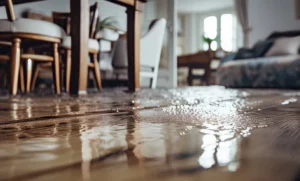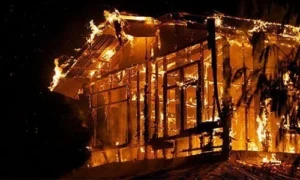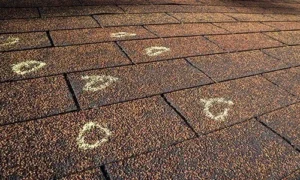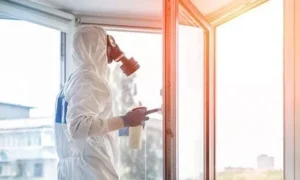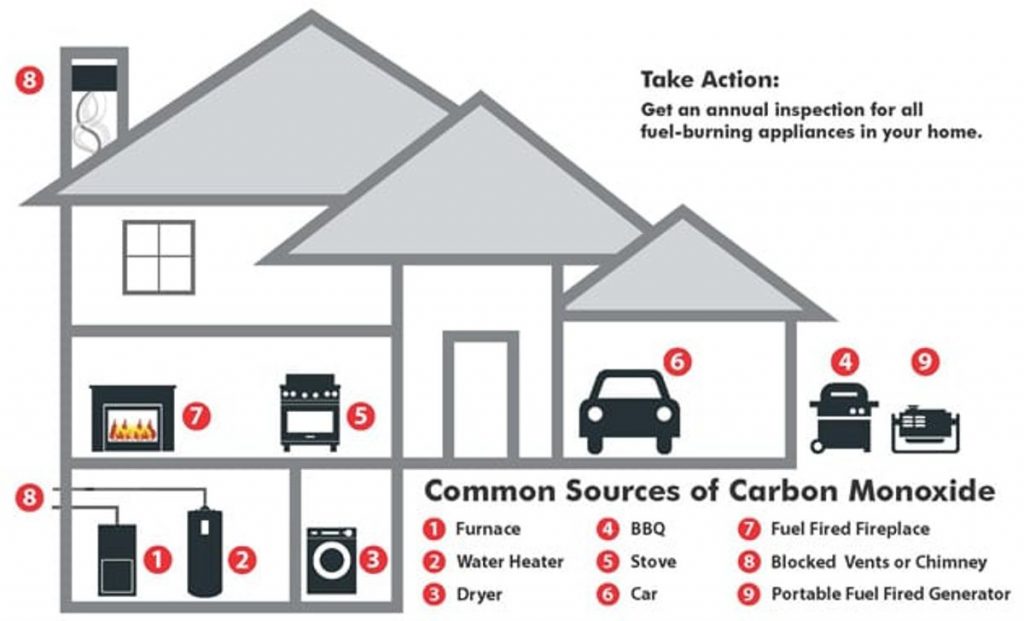
Carbon Monoxide (CO) is a toxic gas produced as a by-product of combustion. It is colorless, odorless, and tasteless. Anything that uses fuel can produce dangerous levels of CO gas. Carbon Monoxide is very dangerous and can lead to serious permanent injury and even death. Mr. Restore cares about our communities’ safety and wants everyone to know the importance of having a carbon monoxide detector. In fact, according to the federal Centers for Disease Control and Prevention, the first two months of the year are the worst for carbon monoxide poisoning. A couple of common examples of devices that produce CO in use around the home include:
- Automobiles
- Fuel furnaces (non-electric)
- Charcoal grills
- Fireplaces
- Gas dryers
- Gas stoves
- Gas water heaters
Injuries and Deaths Caused
There about 200 people per year are killed by accidental CO poisoning according to the Consumer Products Safety Commission (CPSC). An additional 5000 people are injured. These deaths and injuries are normally because of improper use or equipment malfunction. These might be caused by improvements in building construction that limits the amount of fresh air coming into the home.
According to the Texas Poison Center Network, regular maintenance and inspections of your home can minimize the potential of exposure to CO gas. The possibility of a sudden failure, resulting in a life-threatening gas build up, however, will always exist.
Medical Effects of CO and How to Recognize Them
CO blocks the blood’s ability to carry oxygen to body tissues. This can include vital organs like your heart and brain. CO combines with the oxygen-carrying hemoglobin in your blood when you inhale. Together they will form carboxyhemoglobin. Once this happens, that hemoglobin will not be able to transport oxygen, causing major health concerns . The speed that the carboxyhemoglobin builds up depends on two things:
- The concentration of the gas you are inhaling (measured in parts per million or PPM)
- The duration of the exposure
On top of the initial exposure, you have to think about the long half-life of carboxyhemoglobin in the blood. Half-life is a way of measuring how quickly levels return to normal. This is for a set level of exposure after the person is no longer exposed. Carboxyhemoglobin’s half-life is about 5 hours long. Meaning, it will take about 5 hours for the carboxyhemoglobin in the blood to drop to half its current level. Remember, CO is odorless and difficult to detect.
Symptoms
Here are some of the symptoms associated with CO:
- Headache
- Nausea
- Dizziness
- Convulsions
- Loss of Consciousness
- Death
These symptoms are often mistaken for a real case of the flu. This can cause in delayed or misdiagnosed treatments.
How Many CO Detectors to Have and Where to Place Them
It is recommended by the Consumer Product Safety Commission to have a detector on each floor of your home. At a minimum, you need at least one detector on each floor with a bedroom. You will also need another detector around any major gas-burning appliances, like a furnace or water heater. Having them in these areas will make sure you have rapid detection of any potentially malfunctioning appliances. It will also make sure you can hear the alarm from all the sleeping areas.
CO detectors need to be placed high (near the ceiling) for max efficiency. They also shouldn’t be placed within five feet of gas fueled appliances and cooking or bathing areas. Look at the manufacturer’s installation instructions to make sure you have found a good placement.
We also recommend bringing one with you when you travel, it’s an easy thing to pack that can save your life.
What to Do When Your CO Detector Goes Off
The most important thing you can do is stay calm. Most situations that have an activated CO detector aren’t life-threatening. You may not even need to call 911. Ask yourself these questions to figure out if you do need to make that call.
- Does anyone feel ill?
- Is anyone experiencing the ‘flu-like’ symptoms or have a headache, nausea, or dizziness?
If the answer to these questions is yes, you need to evacuate the house. Go to a safe location and have someone call 911. Not evacuating immediately can cause prolonged exposure, which will worsen the effects of CO gas. The first and best thing you should do for CO gas exposure is getting fresh air.
If the answer to these questions is no, then the probability of life-threatening exposure is rather low. You probably don’t need to call 911. Just turn off any gas burning appliances or equipment. Ventilate the area and try to reset the alarm. Call qualified heating and ventilating professional to inspect your system if the alarm won’t reset or goes off again. If someone does begin to feel ill afterward, with the symptoms described previously, evacuate. Go to a safe location and have someone call 911.
Important Information
CO is produced as a by-product of combustion. You cannot have CO if you don’t have fuel burning (non-electric) equipment running. There are, unfortunately, a lot of unreliable CO detectors out there. You also may need to replace your detector if it is over 5 years old.
Mr. Restore not only works hard to restore your home after a disaster but works hard to prevent them from you and your family. Understanding CO and CO monitors will help your family stay safe. In the event that your home suffers from storm, fire, or water damage, immediately contact Mr. Restore. Our experienced technicians will arrive at your property within 60 minutes to assess the damage and help get your home, and life, back to normal.

